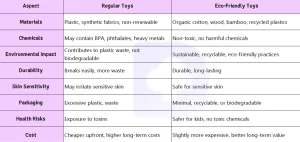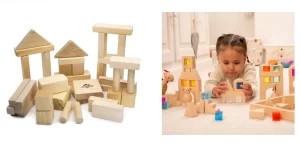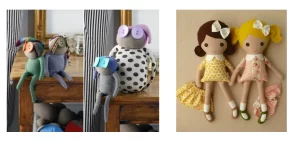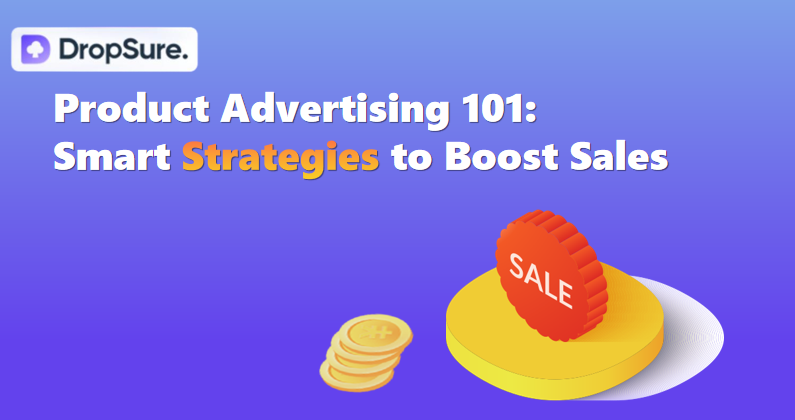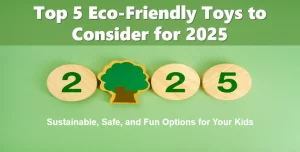
When it comes to choosing toys for your kids, it’s not just about fun anymore—it’s about making sure the toys are safe, durable, and kind to the planet. Eco-friendly toys, including environmentally safe toys, are becoming more popular as parents, like you, make environmentally-conscious decisions that support sustainability. So, lets dive into why eco-friendly toys are so important and how you can pick the best ones for your little one.
5 Eco-Friendly Toys You Should Consider
Now that you know how to choose eco-friendly toys, here are some of the best options to consider in 2025. These toys are not only great for your kids and the environment, but they’re also fun toys for kids that will keep them entertained and engaged!
● Age:3+
● Eco-Friendliness Index:⭐⭐⭐⭐⭐
● Durability:⭐⭐⭐⭐⭐
● Safety:⭐⭐⭐⭐
Wooden building blocks are a classic toy that never goes out of style, and for good reason! Not only are they eco-friendly, but they also help develop a child’s fine motor skills, creativity, and problem-solving abilities. Made from sustainably sourced wood, these blocks are both durable and long-lasting, meaning they can withstand the rough and tumble of childhood play. Plus, they’re timeless, making them a great option to pass down from one generation to the next.Overall, wooden blocks are the go-to choice for parents looking for sustainable and educational fun toys for kids!
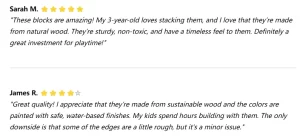
Bamboo Play Sets
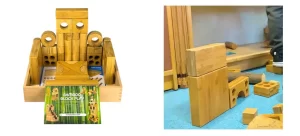
● Age:5+
● Eco-Friendliness Index:⭐⭐⭐⭐⭐
● Durability:⭐⭐⭐⭐⭐
● Safety:⭐⭐⭐⭐
If you’re looking for an eco-friendly toy that’s both fun and sustainable, bamboo play sets are a fantastic option! Bamboo is one of the fastest-growing plants on the planet, making it an incredibly renewable resource. Its sustainability doesn’t just make it good for the environment—it also makes it a strong, durable material for toys. Whether it’s a bamboo kitchen set, a toy car, or even a pretend playhouse, these play sets are built to last through years of playtime.
In addition, Bamboo has a beautiful, natural aesthetic that many parents love. The warm, smooth texture is inviting, and its light color blends well in most playroom setups. Bamboo play sets often look more stylish and timeless compared to plastic toys, and they’re more likely to match a home’s decor.
Organic Cotton Stuffed Animals
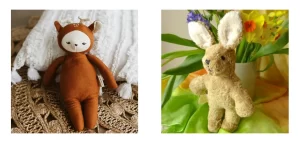
● Age:3+
● Eco-Friendliness Index:⭐⭐⭐
● Durability:⭐⭐⭐
● Safety:⭐⭐⭐⭐⭐
When it comes to plush toys, nothing beats the softness and safety of organic cotton stuffed animals. These cuddly companions are perfect for babies and young children, offering a gentle touch that’s kind to their delicate skin. Organic cotton is grown without the use of harmful pesticides or chemicals—making them safe for little ones to snuggle up with.
In addition to being non-toxic, organic cotton is hypoallergenic, which makes it an excellent choice for children with sensitive skin or allergies. The natural fibers in organic cotton are breathable and gentle, ensuring that your child is comfortable while playing with their new favorite stuffed animal. Plus, since organic cotton is cultivated in a more environmentally friendly way, choosing these stuffed animals supports sustainable farming practices.
Not only are organic cotton stuffed animals safe and comfortable, but they’re also fun toys for kids that can quickly become a child’s best friend.When purchasing organic cotton stuffed animals, it’s also important to check what the toys are filled with. Look for ones that use eco-friendly materials like recycled fabric, organic wool, or other sustainable stuffing alternatives. These fillings are safer for your child and better for the planet compared to traditional synthetic fillings that can take years to break down.
Solar-Powered Robots
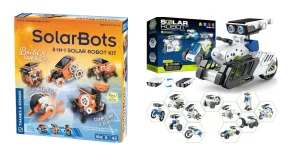
● Age:6+
● Eco-Friendliness Index:⭐⭐⭐⭐
● Durability:⭐⭐⭐
● Safety:⭐⭐⭐⭐
If you’re looking for a toy that’s both educational and eco-friendly, solar-powered robots are a fantastic choice! These innovative toys run on the power of the sun, meaning they don’t need batteries to function. Not only does this eliminate the need for disposable batteries (which can harm the environment), but it also introduces your child to the concept of renewable energy in a fun, hands-on way.
Solar-powered robots come in all shapes and sizes—some are simple, while others are more complex, with moving parts and interactive features. As your child watches the robot move and perform tasks, they’ll be learning about how solar energy works, the importance of sustainability, and the potential for clean energy to power the world. This can spark an early interest in science and technology while giving them a better understanding of the environment.
These toys are made with eco-friendly materials and, since they don’t require batteries, they help reduce electronic waste. With no need for constant recharging or battery replacements, solar-powered robots are an ideal way to keep kids engaged while teaching them valuable lessons about sustainability and green technology.
Recycled Fabric Dolls
● Age:3+
● Eco-Friendliness Index:⭐⭐⭐⭐
● Durability:⭐⭐⭐⭐
● Safety:⭐⭐⭐⭐
Looking for a sweet, sustainable gift that sparks creativity? Recycled fabric dolls are the perfect eco-friendly alternative to traditional plastic or synthetic dolls. These dolls are made from repurposed fabrics, which not only gives old materials a second life but also reduces the need for new resources. By choosing recycled fabric dolls, you’re helping to reduce waste and promote a circular economy where materials are reused rather than discarded.
What’s even better? These dolls are incredibly soft and safe for children, making them ideal for imaginative play. The fabrics used in these dolls are often natural and free from harmful chemicals, ensuring that they’re gentle on your child’s skin. Whether they’re made from cotton, linen, or a blend of other fabrics, these dolls are hypoallergenic, making them a great choice for children with sensitivities or allergies.
Recycled fabric dolls come in all kinds of designs, from simple plush figures to more detailed, hand-crafted creations. They can be found in a variety of sizes, making them perfect for both younger children and older kids who enjoy role-playing and storytelling. Since these dolls are made from reclaimed materials, no two are exactly alike, adding a unique charm to each one.
Why Choose DropSure for Your Eco-Friendly Toy Business in 2025?
If you’re in the eco-friendly toy business or planning to start one, working with a reliable supplier is key. Here’s why DropSure is a great choice for your eco-friendly toy needs in 2025:
1. Automated Inventory Synchronization
DropSure keeps your inventory updated in real-time, so you always know what’s in stock. This helps prevent over-ordering or running out of toys, making sure you have what you need without wasting resources.
2. Streamlined Order Processing
Orders are quickly sent to the right supplier, reducing errors and speeding up the delivery process. Your eco-friendly toys will reach customers faster and with fewer delays.
3. Supplier Management & Optimization
DropSure helps you manage suppliers, ensuring that your toys come from sustainable, high-quality manufacturers. This makes it easier to focus on offering great products while staying true to your eco-friendly values.




 12 min read
12 min read
